
Social Media
Today, we’ll be discussing the major social media platforms that play a crucial role in digital marketing
Key social platforms for digital marketing
First, let’s talk about the value of social media marketing. Social media marketing is a form of digital marketing that aims to increase brand and product visibility and build relationships with consumers by leveraging social networking platforms.
Key benefits of social media marketing include building relationships with customers, utilizing real-time feedback, providing immediate and positive customer experiences, and developing a strong brand identity. Especially, brand identity is built through content posted online that communicates brand values and messages and tells the brand’s story.

Next, let’s examine the relationship between the customer journey and social media.
Recapping the five stages of the customer journey, the primary goal of social media activity is to drive awareness and interest in products and services. Relevant content types and messaging, such as showcasing brand stories, are essential for this purpose.
Metrics relevant for measuring performance include reach and frequency, profile visits, and brand searches.
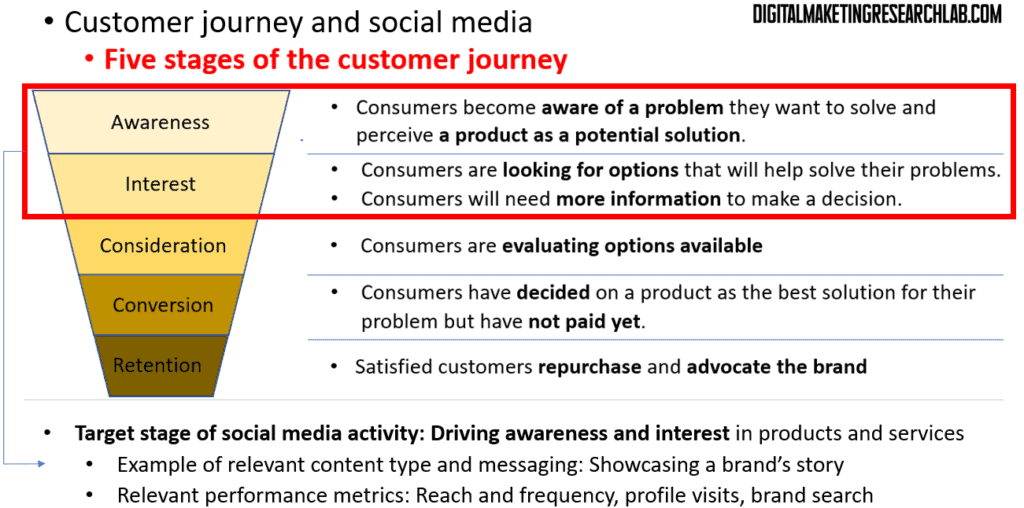
Now, let’s go through the major social media platforms one by one.
First up is Meta, formerly known as Facebook. Facebook is the world’s largest social networking platform, with a mission to enable people to share information and content with others.
It’s also used by brands and businesses to connect with and build relationships with customers. The primary user demographic includes middle-aged to older millennials and beyond. Popular features include events, groups, Facebook Watch (on-demand video service), and recommendations. Facebook excels in reaching a broad audience and attracting diverse demographic groups.
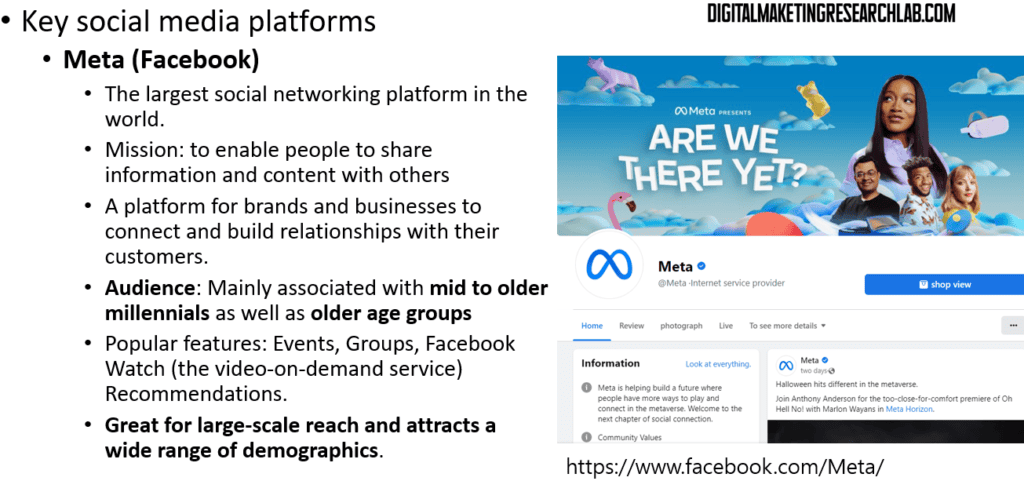
Next, let’s talk about YouTube. YouTube is a video-sharing platform where mobile devices are the primary means of access. Over 70% of YouTube watch time occurs on mobile devices.
The main user demographic is between 15 and 49 years old. Watching videos is the most common activity on YouTube, making it ideal for achieving extensive reach.
Users can also interact with videos through likes, dislikes, shares, saves, and comments. Subscribing to channels helps users see new content more easily in their home feed.
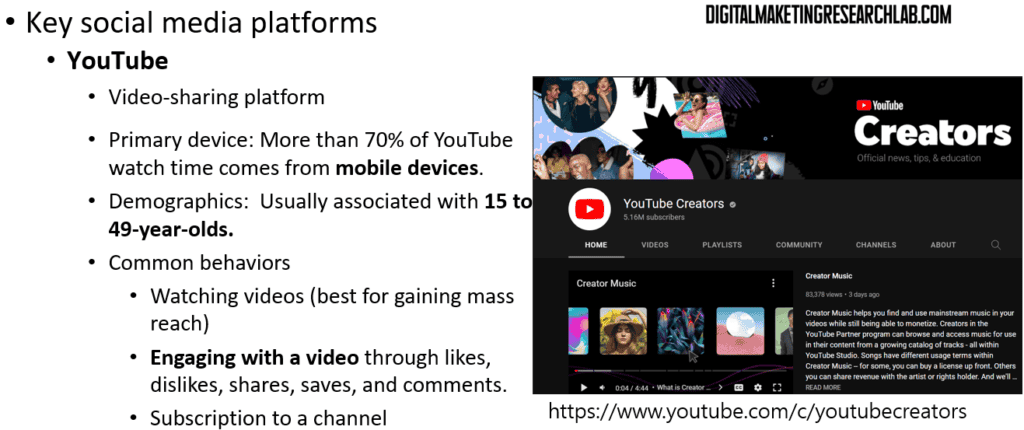
The third platform is Instagram. Instagram is a visual platform for sharing moments and perspectives through photos and videos.
Owned by Facebook, it integrates effectively with Facebook’s advertising platform. It offers a complete visual, mobile experience where users can capture, edit, and share photos and videos.
Instagram’s user base is younger compared to Facebook. The Instagram Stories feature allows users to create temporary content that lasts for only 24 hours.
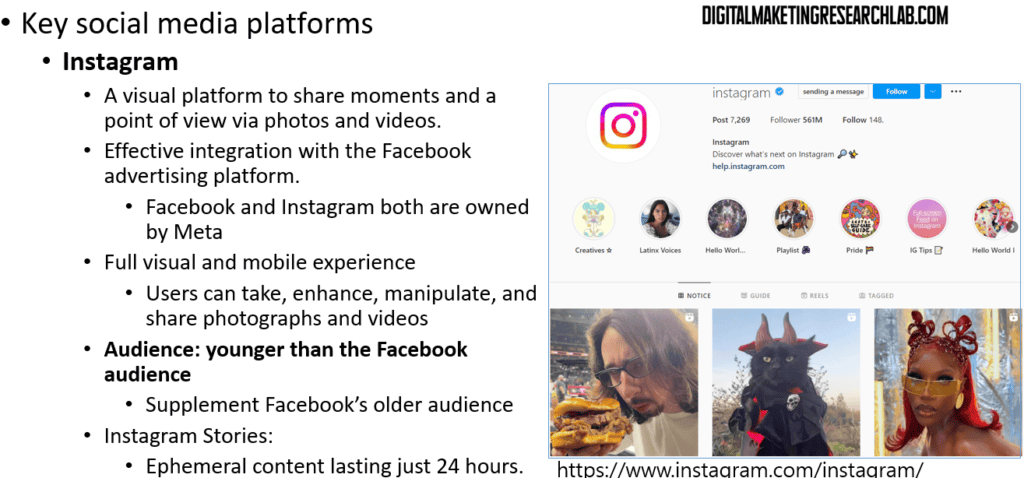
The fourth platform is LinkedIn. LinkedIn is focused on professional networking, making it useful for recruitment, building relationships with current employees, and fostering professional groups.
It’s also suitable for thought leadership and sharing insights for B2B communication. Maintaining an appropriate tone is crucial on LinkedIn, as it requires a more professional atmosphere compared to other social channels.

The fifth platform is X, formerly known as Twitter. X is a social network where users can send and read short posts known as “tweets.”
It has strong interactive features and is useful for discovering content through hashtags. It’s excellent for engaging with major cultural moments or real-time events. Additionally, many people use X for immediate customer service, so it’s important for service representatives to regularly monitor and respond on this platform.
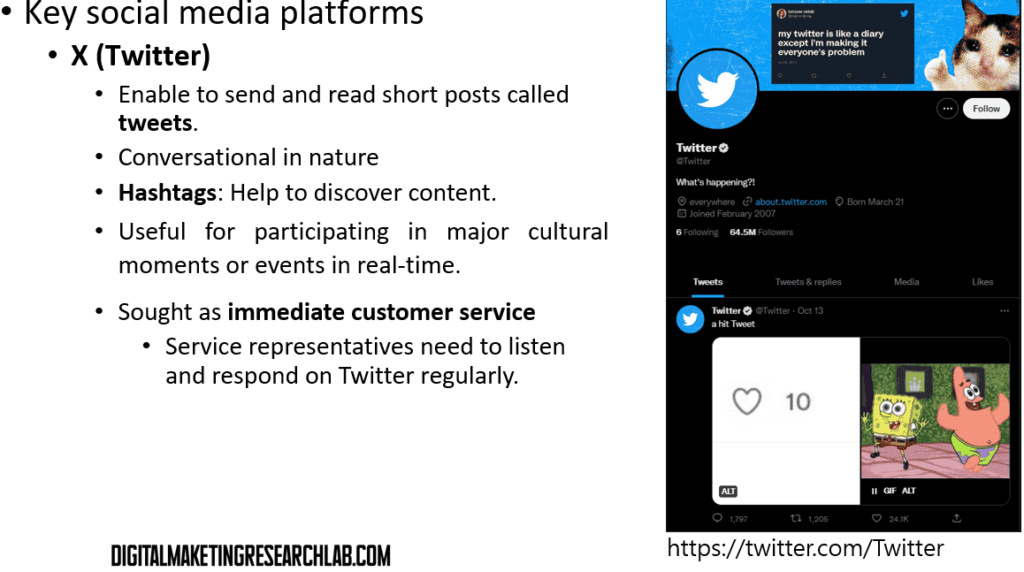
The sixth platform is Pinterest. Pinterest is a social network where users can visually share and discover new interests.
Users “pin” images or videos to boards themed around specific topics and explore pins from other users. Each idea is represented as a Pin, which users search for and save.
Pinterest’s user base includes a significant portion of American millennials, making it useful for showcasing products and services and helping users find more information about what they want to buy.

Next, let’s discuss WhatsApp. WhatsApp is a free personal messaging app that supports one-on-one and group messaging.
It also offers file sharing, and free voice and video calls. Businesses can use WhatsApp to receive real-time feedback from customers and provide updates on products and promotions. WhatsApp Business is a free professional version that allows brands to use a separate WhatsApp profile for business communications.
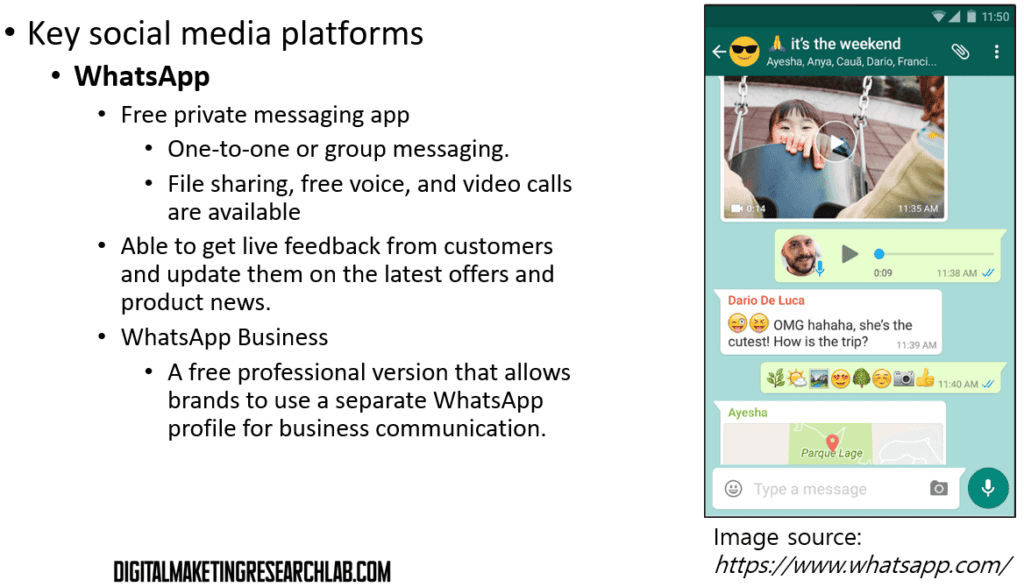
Finally, let’s introduce Snapchat. Snapchat is a multimedia messaging app known for its temporary content.
It offers augmented reality features, including face lenses, Geofilters, Bitmojis, and drawing tools. Snapchat is particularly popular among younger users. This concludes our introduction to the major social media platforms. By understanding and effectively utilizing the features of each platform, you can develop a successful digital marketing strategy.

Let’s explore some key terminology used across social media platforms that are essential for digital marketers to understand.
First, we have the ‘Newsfeed‘. Also referred to as the home feed or timeline, the Newsfeed is the center of content discovery on each social platform. It’s where you see posts from friends, brands you’re connected with, and advertisements from organizations that want to reach you. The Newsfeed is crucial for marketers as it’s the primary space where your content will be seen by your audience.
Next, let’s talk about ‘Engagement’. Engagement refers to any interaction that users take on a social post. This includes likes or reactions, comments, retweets or regrams, shares, and so on. Engagement is a key metric for measuring the success of your social media efforts, as it indicates how well your content resonates with your audience.
Then we have ‘Username‘ or ‘Handle‘. These are used to identify people and brands on platforms like Twitter, Instagram, and Snapchat. They’re usually preceded by the @ symbol. For example, @YourBrandName. Your username is an important part of your brand identity on social media, so choose it wisely.
Fourth, let’s discuss ‘Blocking‘. This is a feature that allows users to remove followers and prevent them from re-following, mentioning, direct messaging, or otherwise contacting you on the platform. While it’s not something you’ll use often as a brand, it’s important to understand this feature for managing your social media presence and dealing with potential issues.
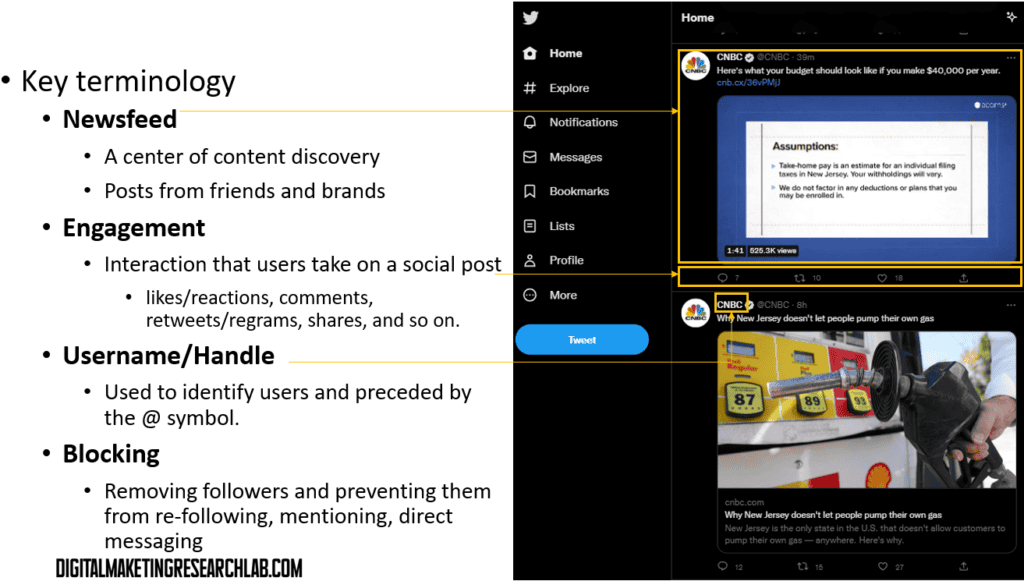
Then, a Mention is a post or comment that contains another user’s username anywhere in the body of the message. It’s a way to directly address or involve someone in a conversation on social media.
Next, we have ‘Followers‘ or ‘Fans’. These are users who have subscribed to receive and view your posts in their feed. They’re essentially your audience on social media platforms.
Lastly, Stories are a feature that allows users to share ephemeral moments from their day. These posts appear together in a slideshow format, creating a visual story that typically disappears after 24 hours. This feature has become increasingly popular across various social media platforms. Understanding these terms is crucial for effective communication and strategy on social media platforms.
Understanding these terms will help you navigate the social media landscape more effectively and communicate more clearly about your social media strategies and performance.”

Setting up a social media experience for a business
Now, let’s move on to setting up a social media experience for your business.
The best approach when setting up your social media presence is to carefully consider your options. Most businesses are active on more than one platform, so you might decide to set up accounts on a few different channels. However, it’s crucial to start by creating a profile, and always choose the business version of the platform when doing marketing for an organization.
Your profile picture and cover photo are vital elements. Remember, making a strong first impression is crucial on social media as users quickly move between profiles and feeds. Always choose images that depict your brand in a positive or engaging way. For example, use your brand logo as your profile picture or an engaging image that represents your brand. It’s a good practice to update these regularly to fit with your marketing calendar. For instance, you might add snow to your logo at Christmas time or love hearts on Valentine’s Day.
Your bio is another crucial element. Use it to introduce your business and what you do. Make sure that the tone of the bio is appropriate to your audience and consistent with your brand’s own tone of voice.
Lastly, consistency across all your social media platforms is key. Ensure that the images, videos, and text that you use are consistent with your brand. You may have conversations with the same people on multiple platforms, so you’ll want to position your brand in a way that’s easy for them to recognize and engage with. By following these guidelines, you’ll be well on your way to creating a strong and effective social media presence for your business.
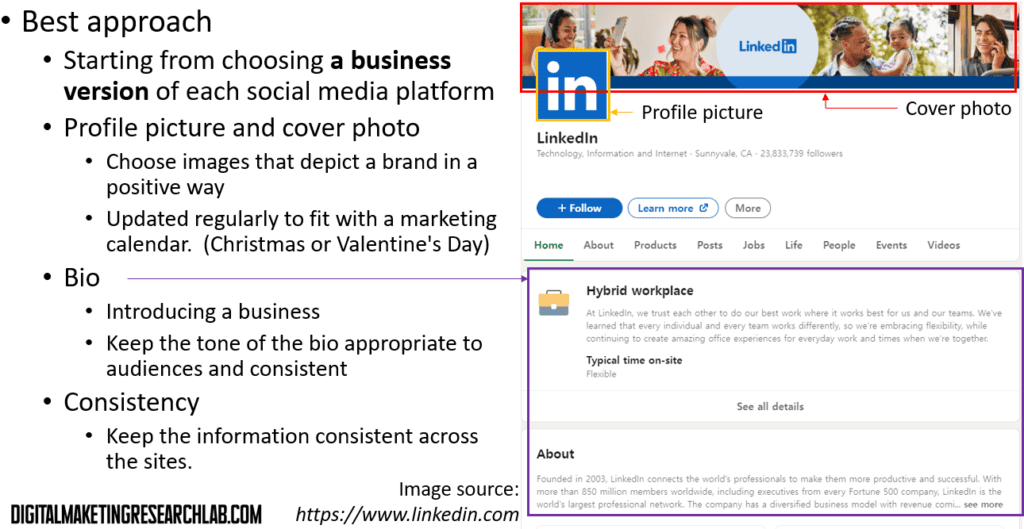
Growing and engaging an audience using social media
Then, let’s discuss the importance of growing and engaging an audience using social media. Let’s start by looking at the value of building a social media community.
A social media community is essentially a group of individuals who share a common interest around a particular topic, goal, or interest. These communities are incredibly valuable for businesses for several reasons.
First, they promote engagement. Every time a user actively engages with your content, it brings them closer to your brand. This increased engagement also leads to greater brand visibility on the platform, which in turn attracts more potential customers to your business profile.
Moreover, a well-managed community creates a welcoming and engaging environment. This fosters brand affinity and loyalty, as community members will associate your brand with their positive experiences within the community.
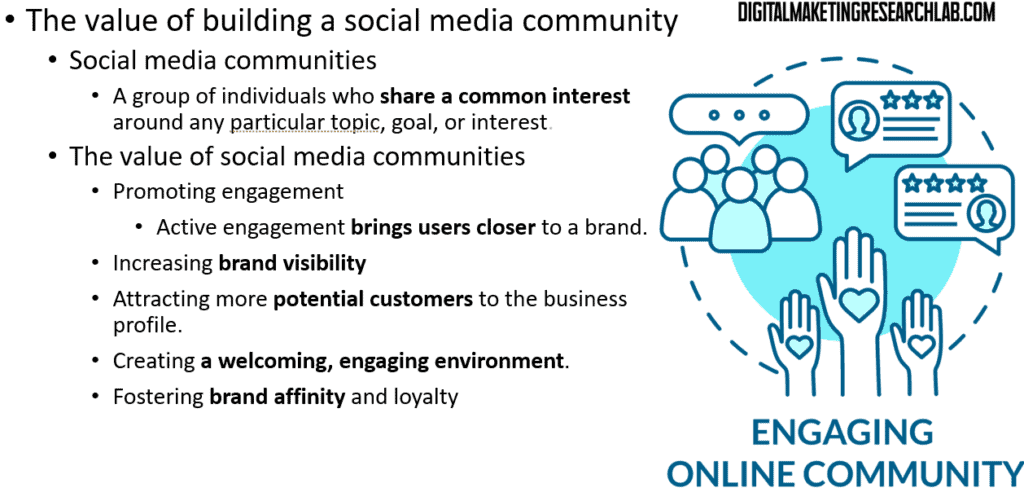
Now, let’s explore how to build a social media community. There are several strategies you can employ:
Start by inviting your friends. They can support you by interacting with your posts and sharing your content, which helps establish credibility, build your reputation, and spread word-of-mouth.
Next, welcome your customers. Let them know about your brand-new community and the benefits of joining. You can do this via email or when you speak to them directly.
Adding social buttons to your website is another effective strategy. Showcase the logos of your active social media platforms across your brand website. This allows your customers to easily find and connect with you on their preferred platforms.
Cross-promoting your social networks is also crucial. This enables your followers to find you on each platform they’re active on, maximizing your reach.
Don’t forget to include social links in your email signatures. This simple step can significantly increase exposure for your pages and help build a loyal follower base.
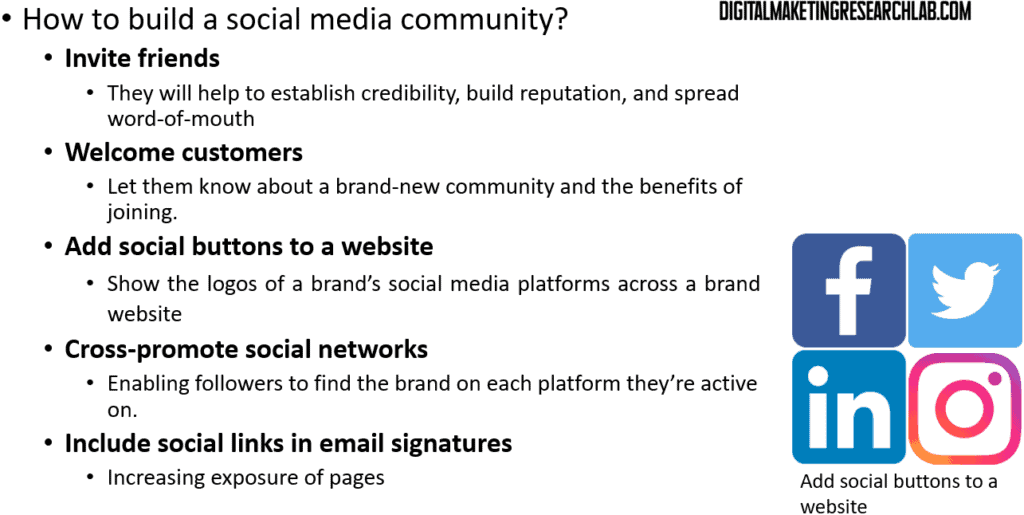
Continuing with our strategies for building a social media community:
Joining platform groups relevant to your business can be highly beneficial. For example, on LinkedIn, you might join groups like “Social Media Marketing” or “Digital Marketing”. These groups allow you to share interesting content and engage with potential community members.
Using events is another great way to build your community. Encourage followership in-store or at events. You might even consider offering discounts for new fans and followers to incentivize them to join your community.
Creating goodwill amongst other users is crucial on social media platforms. Follow other relevant accounts – it may inspire them to follow you in return. Maintain a consistent posting schedule to demonstrate that you’re reliable, which fosters trust within your community.
Remember to use emojis and colloquial terms when relevant. This shows that you speak the language of the community, making your brand more relatable and fostering affinity.

Let’s discuss a few more strategies for building and maintaining your social media community:
It’s imperative to respond to your community. If your followers feel like they’re only being spoken at and not engaged in a conversation, they may assume that your business is self-serving and doesn’t really care about their needs. Responding to your followers humanizes your brand and increases affinity.
Using GIFs, emojis, quote images, and memes can make your content more engaging, relatable, and shareable. When used relevantly, these elements can make your brand more likable.
Offering special promotions to your followers is a great way to reward the community. This demonstrates that you care about them and want to recognize their loyalty and engagement. It’s a classic example of positive reinforcement that encourages continued loyalty and increases brand affinity.
Lastly, consider working with influencers. You can collaborate with them to help increase awareness of your account and build your community. This could involve allowing them to take over your page for a set period or creating content with a call-to-action to follow your brand’s account.
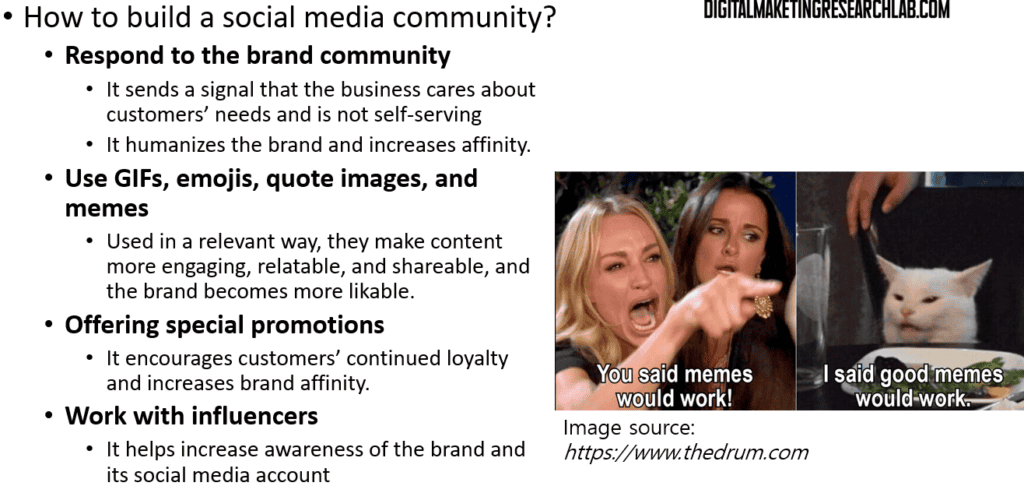
Now that we’ve covered how to build a community, let’s talk about how to manage it effectively:
First and foremost, develop a consistent brand voice and tone. Your community appreciates honesty and dependability, so ensure your messaging reflects this.
Be responsive and engage with your followers. The more you engage, the more they feel appreciated and compelled to continue participating. Remember, engagement creates more engagement.
It’s crucial to monitor reactions to your content. Pay attention to what posts are resonating with your audience, both on your own channels and on competitor channels. Then, optimize your content strategy accordingly. When it comes to sharing content, follow the 80/20 rule: 80% of the content you share should be helpful to your audience and cater to their interests, while still supporting ideas and insights that your brand believes in. Only 20% or less should be about promoting your business directly.
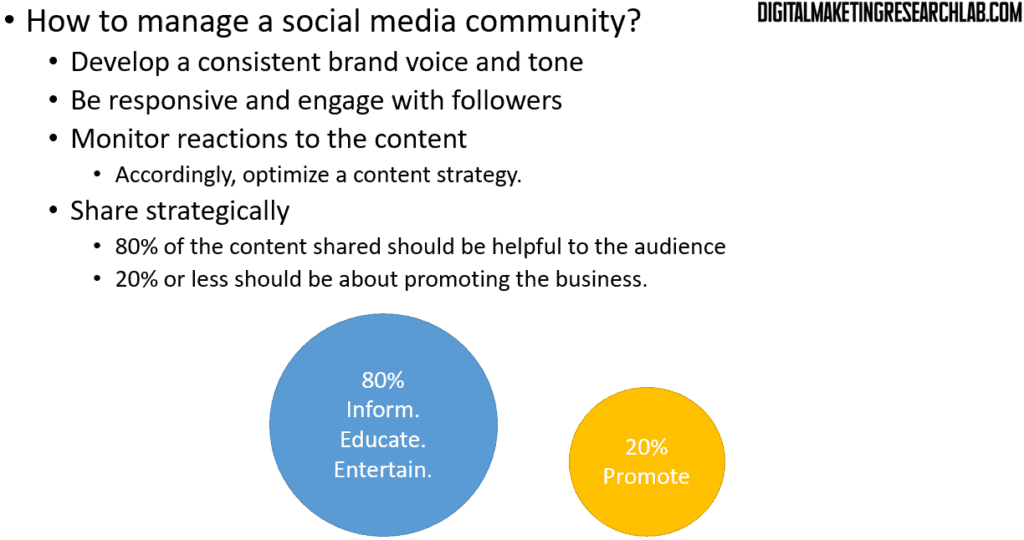
Let’s dive into some best practices for managing content on social media platforms:
First, be succinct and relevant. Attention spans are shorter than ever, so you need to make your point quickly. Ensure your post is topical and relevant to your audience.
Include clear calls-to-action (CTAs) in your posts. Let your audience know exactly what you want them to do with the information you’re providing – whether it’s to comment, like, or share.
Incorporate rich media into your posts. In today’s cluttered newsfeeds, it’s hard to capture people’s attention. Using photos or videos can make your posts stand out to your consumers.
Engage your audience by asking questions or running polls. This not only increases engagement but also helps you learn more about your audience’s preferences and interests.

Now, let’s talk about using stories on social media platforms:
Stories are temporary content that can show an authentic, raw side of your brand. You can use them to share photos, interviews, and exclusive behind-the-scenes content.
Working with influencers can be particularly effective with stories. Consider having them take over your story feed for a whole day. This is a great way to grab users’ attention and share key messaging points.
When creating stories, be sure to have a clear narrative about whatever you’re promoting. And don’t forget to include a clear call-to-action, like a promo code or a link to your website, that will drive a trackable action from your consumers.
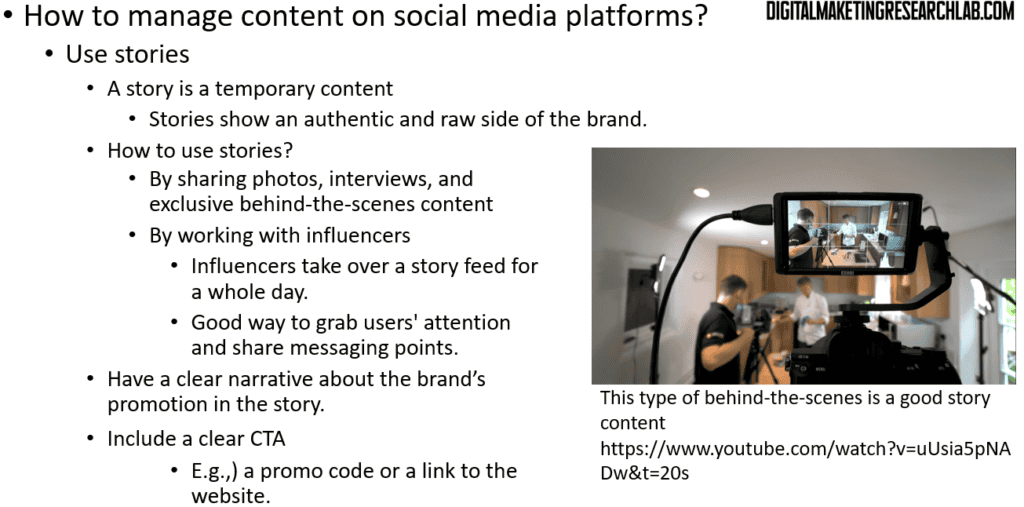
Let’s move on to discussing the use of hashtags in your social media strategy:
A hashtag is a word or phrase preceded by the number sign or hash sign. It’s used to categorize keywords or topics, allowing users to easily find or follow specific conversations of interest.
When using hashtags, consider these best practices:
Use SEO keywords as hashtags. They’re often short and easily searchable.
Don’t use spaces or punctuation in your hashtags, as this breaks the tag and makes it unsearchable.
Capitalize your hashtags correctly to increase readability and legibility.
Avoid overusing hashtags in a single post, as it may appear spammy and inauthentic.
Keep your hashtags short to increase memorability and searchability.

Continuing with our discussion on hashtags:
Use popular hashtags that are frequently searched by users on the platform. This makes your content far more discoverable.
Consider creating branded hashtags that are unique to your brand or business. This could be your company name, tagline, campaign name, or contest name.
Lastly, don’t forget to monitor other hashtags in your community that may be relevant to your brand or business. You need to ensure that these hashtags aren’t being used negatively in a way that could reflect poorly on your brand.
By following these strategies and best practices, you’ll be well on your way to growing and engaging a thriving social media community for your brand. Remember, building a community takes time and consistent effort, but the rewards in terms of brand loyalty and engagement are well worth it.
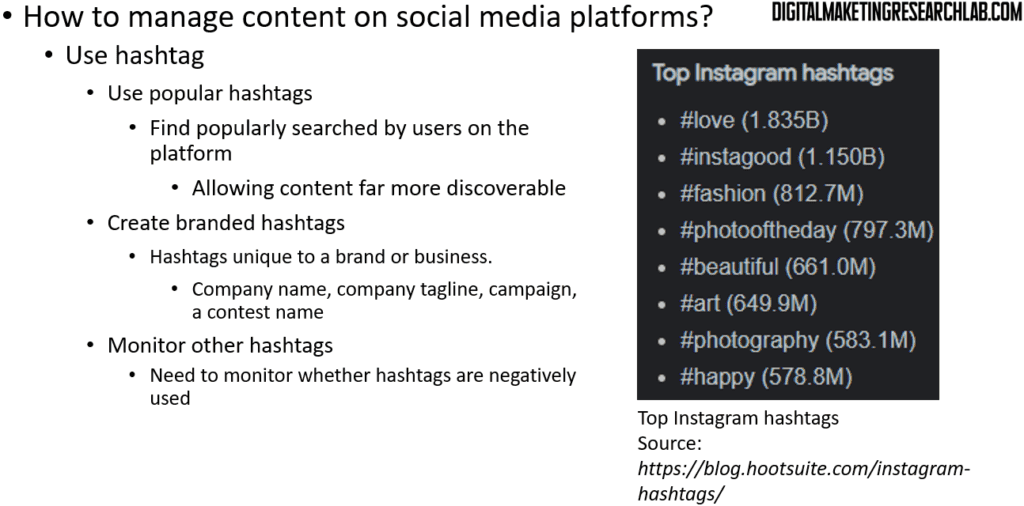
Conclusion
Social media platforms have become essential tools for digital marketing, offering businesses unique opportunities to build brand awareness, engage with customers, and foster loyal communities. Effective social media marketing requires a strategic approach, including careful platform selection, consistent brand messaging, and the creation of engaging, relevant content tailored to each platform’s strengths. By understanding the nuances of each platform, utilizing key features like hashtags and stories, and actively managing their online communities, businesses can leverage social media to significantly enhance their digital presence and drive meaningful customer relationships.

*Reference
Hanlon, A. (2021). Digital marketing: strategic planning & integration. Sage.
Digital Marketing Institute (2021). Introduction to Digital Marketing.